This article needs additional citations for verification .(March 2011) |
A poorhouse or workhouse is a government-run (usually by a county or municipality) facility to support and provide housing for the dependent or needy.
This article needs additional citations for verification .(March 2011) |
A poorhouse or workhouse is a government-run (usually by a county or municipality) facility to support and provide housing for the dependent or needy.

In England, Wales and Ireland (but not in Scotland), [1] "workhouse" has been the more common term. Before the introduction of the Poor Laws, each parish would maintain its own workhouse; often these would be simple farms with the occupants dividing their time between working the farm and being employed on maintaining local roads and other parish works. An example of one such is Strand House in East Sussex. In the early Victorian era (see Poor Law), poverty was seen as a dishonourable state. As depicted by Charles Dickens, a workhouse could resemble a reformatory, often housing whole families, or a penal labour regime giving manual work to the indigent and subjecting them to physical punishment. [2] At many workhouses, men and women were split up with no communication between them. Furthermore, these workhouse systems were instituted under the Poor Law Amendment Act 1834 : The United Kingdom passed this act to attempt to cut expenditure on those in poverty, reduce the number of beggars on the street, and inspire lower-class people to work harder in order to better provide for themselves. [3]
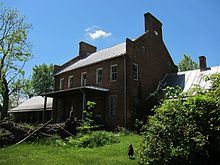
In the United States, poorhouses were most common during the 19th and early 20th centuries. They were often situated on the grounds of a poor farm on which able-bodied residents were required to work. A poorhouse could even be part of the same economic complex as a prison farm and other penal or charitable public institutions. Poor farms were county- or town-run residences where paupers (mainly elderly and disabled people) were supported at public expense. They were generally under the direction of one or more elected or appointed "Superintendent[s] of the Poor."
Most were working farms that produced at least some of the produce, grain, and livestock they consumed. Residents were expected to provide labor to the extent that their health would allow, both in the fields and in providing housekeeping and care for other residents. Rules were strict and accommodations minimal.
Poor farms were based on the U.S. tradition of county governments (rather than cities, townships, or state or federal governments) providing social services for the needy within their borders. Following the 1854 veto of the Bill for the Benefit of the Indigent Insane by Franklin Pierce, the federal government did not participate in social welfare for over 70 years.
The poor farms declined in the U.S. after the Social Security Act took effect in 1935, with most disappearing completely by about 1950. Since the 1970s, funding for the care, well-being and safety of the poor and indigent is now split among county, state and federal resources. Poor farms have been replaced by subsidized housing such as public housing projects, Section 8 housing and homeless shelters.
In Canada, the poorhouse, with an attached farm, was the favoured model. According to a 2009 report by the Toronto Star , "pauperism was considered a moral failing that could be erased through order and hard work". [4] The oldest government-supported facility of this type that is still standing (now a museum), is located in Southern Ontario between Fergus and Elora. The Wellington County House of Industry and Refuge was opened in 1877 and, over the years, housed approximately 1500 deserving poor, including those who were destitute, old and infirm, or disabled. The 60-bed house for inmates was surrounded by a 30-acre industrial farm with a barn for livestock that produced some of the food for the 70 residents and the staff and also provided work for them. [5] Others worked in the House itself. A hospital was added in 1892. The nearby cemetery has 271 plots. [6] In 1947, the House was converted into a home for the aged and in 1975 the building reopened as the Wellington County Museum and Archives, one of the National Historic Sites of Canada. [7]

The English Poor Laws were a system of poor relief in England and Wales that developed out of the codification of late-medieval and Tudor-era laws in 1587–1598. The system continued until the modern welfare state emerged after the Second World War.
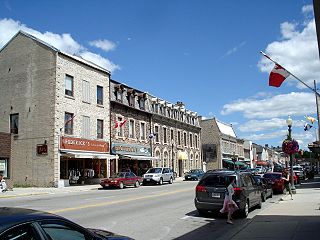
Wellington County is a county located in Southwestern Ontario, Canada and is part of the Greater Golden Horseshoe. The county, made up of two towns and five townships, is predominantly rural in nature. However many of the residents in the southern part of the county commute to urban areas such as Guelph, Kitchener, Waterloo, Brampton, Mississauga, Toronto and Hamilton for employment. The northern part of the county is made up of mainly rural farming communities, except for a few larger towns such as Mount Forest and Arthur. According to the 2021 census, the population of the county was 241,026.
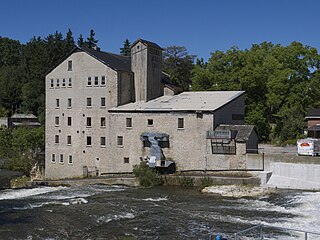
Elora is a community in the township of Centre Wellington, Wellington County, Ontario, Canada. It is well known for its 19th-century limestone architecture and the geographically significant Elora Gorge.
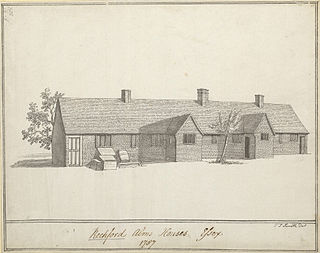
An almshouse is charitable housing provided to people in a particular community, especially during the Middle Ages. They were often targeted at the poor of a locality, at those from certain forms of previous employment, or their widows, and at elderly people who could no longer pay rent, and are generally maintained by a charity or the trustees of a bequest. Almshouses were originally formed as extensions of the church system and were later adapted by local officials and authorities.

Centre Wellington is a township in south-central Ontario, Canada, located in Wellington County. The primary communities are Elora and Fergus. The area is agricultural but also includes industries such as manufacturing. In the Canada 2016 Census, the population was stated as 28,191.

In Britain and Ireland, a workhouse was an institution where those unable to support themselves financially were offered accommodation and employment. In Scotland, they were usually known as poorhouses. The earliest known use of the term workhouse is from 1631, in an account by the mayor of Abingdon reporting that "we have erected wthn [sic] our borough a workhouse to set poorer people to work".

Fergus is the largest community in Centre Wellington, a township within Wellington County in Ontario, Canada. It lies on the Grand River about 18 km NNW of Guelph. The population of this community at the time of the 2016 Census was 20,767, but the community is growing as new homes are being built for sale.

The Poor Law Amendment Act 1834 (PLAA) known widely as the New Poor Law, was an Act of the Parliament of the United Kingdom passed by the Whig government of Earl Grey denying the right of the poor to subsistence. It completely replaced earlier legislation based on the Poor Relief Act 1601 and attempted to fundamentally change the poverty relief system in England and Wales. It resulted from the 1832 Royal Commission into the Operation of the Poor Laws, which included Edwin Chadwick, John Bird Sumner and Nassau William Senior. Chadwick was dissatisfied with the law that resulted from his report. The Act was passed two years after the Representation of the People Act 1832 which extended the franchise to middle-class men. Some historians have argued that this was a major factor in the PLAA being passed.
Eloise Psychiatric Hospital was a large complex located in Westland, Michigan. It was named after Eloise Dickerson Davock, the daughter of Detroit's postmaster.
A poor law union was a geographical territory, and early local government unit, in Great Britain and Ireland.

The Poor Relief Act 1601 was an Act of the Parliament of England. The Act for the Relief of the Poor 1601, popularly known as the Elizabethan Poor Law, "43rd Elizabeth" or the Old Poor Law was passed in 1601 and created a poor law system for England and Wales.

In English and British history, poor relief refers to government and ecclesiastical action to relieve poverty. Over the centuries, various authorities have needed to decide whose poverty deserves relief and also who should bear the cost of helping the poor. Alongside ever-changing attitudes towards poverty, many methods have been attempted to answer these questions. Since the early 16th century legislation on poverty enacted by the Parliament of England, poor relief has developed from being little more than a systematic means of punishment into a complex system of government-funded support and protection, especially following the creation in the 1940s of the welfare state.
From the reign of Elizabeth I until the passage of the Poor Law Amendment Act 1834 relief of the poor in England was administered on the basis of a Poor Relief Act 1601. From the start of the nineteenth century the basic concept of providing poor relief was criticised as misguided by leading political economists and in southern agricultural counties the burden of poor-rates was felt to be excessive (especially where poor-rates were used to supplement low wages. Opposition to the Elizabethan Poor Law led to a Royal Commission on poor relief, which recommended that poor relief could not in the short term be abolished; however it should be curtailed, and administered on such terms that none but the desperate would claim it. Relief should only be administered in workhouses, whose inhabitants were to be confined, 'classified' and segregated. The Poor Law Amendment Act 1834 allowed these changes to be implemented by a Poor Law Commission largely unaccountable to Parliament. The act was passed by large majorities in Parliament, but the regime it was intended to bring about was denounced by its critics as un-Christian, un-English, unconstitutional, and impracticable for the great manufacturing districts of Northern England. The Act itself did not introduce the regime, but introduced a framework by which it might easily be brought in.
The Scottish poor laws were the statutes concerning poor relief passed in Scotland between 1579 and 1929. Scotland had a different poor law system to England and the workings of the Scottish laws differed greatly to the Poor Law Amendment Act 1834 which applied in England and Wales.

The Western House of Refuge was a prison for children in Rochester, New York founded in the mid-1800's that was the first state managed reformatory in the United States. In the 1880's, the prison was changed into a vocational school known as the State Industrial School. In the early 1900's, the school would move to Industry, New York, where it now operates as the Industry Residential Center run by the state Office of Children and Family Services.
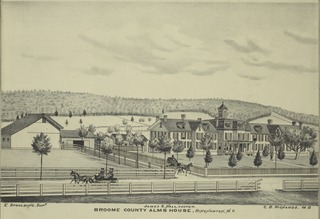
The Broome County Alms House, was located in the town of Dickinson, three miles north of Binghamton in Broome county, New York. The red brick building operated as a shelter for the poor, take care of the sick, disabled, mentally unwell, widowed, and orphaned persons in the community until c. 1960. The goal of the almshouse was to both help break the cycle of poverty and to care for members of the community who had no means of caring take of themselves. The building was demolished on February 5, 2010.
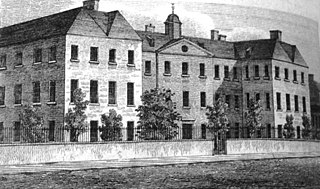
The Scottish poorhouse, occasionally referred to as a workhouse, provided accommodation for the destitute and poor in Scotland. The term poorhouse was almost invariably used to describe the institutions in that country, as unlike the regime in their workhouse counterparts in neighbouring England and Wales residents were not usually required to labour in return for their upkeep.
The Bedwellty Union Workhouse was situated in Georgetown, Tredegar. It is 2.9 miles (4.7 km) from the Nanybwtch Junction A465. The building was in existence for approximately 127 years. The workhouse building was also used as a hospital. Today, the site where the building once stood, there is a housing estate known as St James Park.
Workhouse infirmaries were established in the nineteenth century in England. They developed from the Workhouse and were run under the Poor law regime.
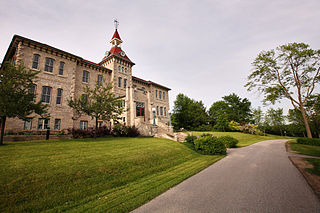
The Wellington County House of Industry and Refuge, located in Fergus, Ontario, is the oldest surviving state-supported poorhouse in Canada. Constructed in 1877, the site operated as a poorhouse and farm until 1947, and as an old age home until 1971. In the 1980s, the building was repurposed to house the Wellington County Museum and Archives. The Wellington County House of Industry and Refuge was designated a National Historic Site of Canada in 1995 based on its illustration of 19th century attitudes towards poverty and the origins of Canada's social safety net.
The House of Industry and the Bank Barn were built in 1877. The House of Industry and Refuge or "Poor House" provided a home for the "deserving poor" of Wellington County. The Barn and Industrial Farm were an important part of the House. The Farm grew produce and livestock to feed the inmates (residents) and staff at the House. The Farm also provided work or "industry" for the inmates. In the 19th century, Industrial Farms were a vital part of public institutions like hospitals, prisons, asylums and Houses of Refuge.
This is the earliest surviving example of an important 19th century institution, the government-supported poorhouse. Erected in 1877, it was the shelter of last resort for the homeless and destitute, who traded spartan accommodations for domestic or agricultural labour. With changing attitudes and the introduction of alternative forms of social assistance, its function shifted to the care of the elderly and infirmed and additions were built to respond to their special needs. Closed in 1971, this building, and its history, illustrate the Victorian roots of the 20th-century social security system in Canada.